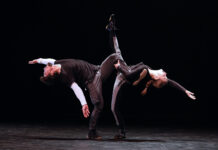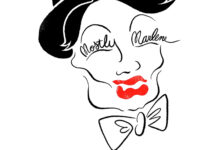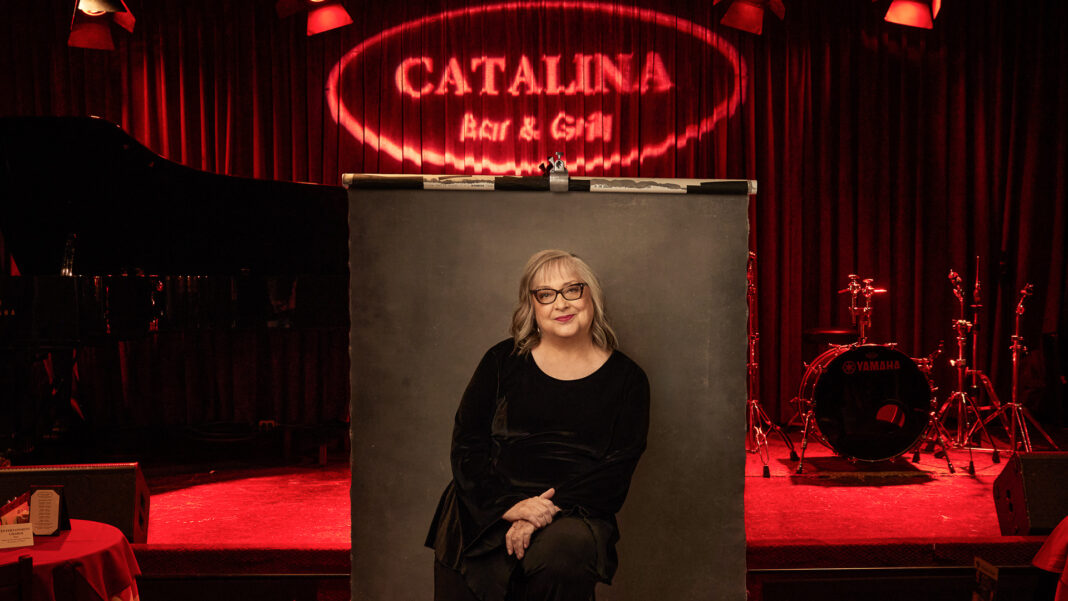There aren’t too many people who grow up in Romania and dream of running a jazz club. Even fewer are those who accomplish their dreams. Catalina Popescu is one of those very few. She and her late husband, Bob, opened Catalina Bar & Grill on Cahuenga Boulevard in Hollywood in 1986. In 2003, after a three-year search, she found a new home for the club which now goes under the name Catalina Jazz Club.
The pandemic did Catalina (both the woman and the club) no favors. It took a lot of effort and the support of jazz music fans from around the world to keep the club afloat. But she’s still here and so is her club. But Popescu still faces very changing times in the music industry.
Her dream, the shifting sands of live music and the future of her club were all on the table when we spoke last week. What follows are excerpts from our conversation that have been edited for length and clarity. To see the full interview, please go to our YouTube channel.
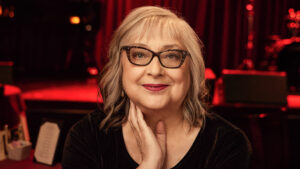
About 13 years ago, you did an interview with Agenda Magazine where you were asked about favorite artists that had performed at Catalina. Part of your answer was, “There is really something to learn about somebody that is going through life in different places and different social environments.” You were in a different place as anyone would be after those 13 years. That also included the pandemic. How has your perspective changed on life, the business of live music and the role of live music in your own life?
This period has been very difficult. We tried as much as possible to keep music alive even in that period. I still feel there is nothing like live music. Everybody tried all kinds of virtual things to do this. Yes, it was fine for the moment, but it’s nothing like live music. When we came back and we presented again live music, everybody that came to see the shows. They felt like they were born again.
Did you feel born again in that moment, too?
Absolutely. And believe me it wasn’t that easy. When we got back everything in the place was broken from not being used, including air conditioning, freezers, refrigerators, everything. So as we were fighting with all of that, we had the music going on. And believe me, that made the big difference.
How have you seen the jazz scene change in Los Angeles since you first opened the club?
The jazz scene in Los Angeles has been having some ups and downs during all these 36 or 37 years. I have had times when jazz was very up and cool. And I have had times when the jazz was put to the backburner like nobody was interested. Now I feel that everybody’s thirsty for live jazz. And people come young, old, in between, and they enjoy every little bit of it.
Did the move from Cahuenga to Sunset Boulevard require a complete rethinking? Were there things that you learned in that move that you’ve now been able to apply for the 20 years or so that you’ve been on Sunset?
We looked for this place for more than three years prior to finding it, because we wanted to have a place which was bigger. But to resemble in some way the old place so people wouldn’t feel that they had to change everything. This was a warehouse before, so I designed everything to look almost like the old place. I still have people coming saying that they like better the other place. That was fine, but was very small. What I try [sic] to do is to find a place that had a lot of parking, to find a place that was safer and the place that had good sound.
What are the challenges in booking major jazz artists today?
Big challenges. Especially after the pandemic. Everybody was sitting without doing anything. So when everything else opened, everybody felt that they are now in a pot of gold – which maybe was true. Some was not. But we still have a lot of problems booking because of pricing. Everything went up. The airline tickets are up. The hotel prices are up. Everything going crazy. And, of course, musicians, because they lost so much money, feel that they need to recoup everything.
Even before the pandemic artists like Brad Mehldau or Jason Moran can play a week at the Village Vanguard in New York. But when they come to Los Angeles, they feel the need to play Walt Disney Concert Hall or the Soraya.
Here in Los Angeles they have more possibilities, more places to choose from. I don’t understand what the problem is. But now we are almost the only place still standing and we still have a very difficult time bringing these musicians that you mentioned because of prices.
How do you work around that?
We find them sometimes on the way in a tour. So if they don’t have anything else, they would make a stop here. Or we try to do better price-wise. Even if we lose a little bit of money, it’s okay. I have to have a lot of thinking and a lot of calculation in everything that I do.
I’ve spoken to several jazz artists who say that they would love to find a smaller venue in Los Angeles, but they suggest that you require they rent out the facility rather than being paid as booked artists. Is that true?
No, that’s not true. None of it is.
How would they get that impression?
I don’t know. That’s never true to do that. Never. The way we work sometimes if somebody is totally unknown, we ask them for a deposit, and that is only to get them involved. The moment we got the people in and we got the show on, they get the deposit back. So no, that’s not true.
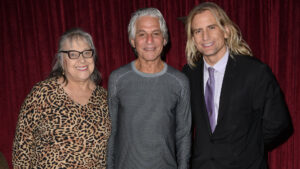
In the early days of the club your dream was to get Dizzy Gillespie there. Who in on your list of people you’d love to see perform there now?
When he came and I saw him on my stage here, I had to pinch myself. I just couldn’t believe it. Who I would like to see? I would like to see more of the musicians I already worked with. Like the ones you mentioned, like Stanley Clarke, like Marcus Miller to come back. Probably he will be back in in October. I would like to see more singers like Oleta Adams. Let me see what else? Because we lost a lot of them. That was very painful.
Not too long ago we lost Ahmad Jamal. He was one of our dearest friends when we opened this place. Ahmad Jamal was scheduled to perform for the opening and we didn’t get the permit from the health department. So myself, my husband and Ahmad Jamal, we are here in the audience looking at the beautiful piano on the stage, not being able to [have a] show.
I was able to find an interview that you did as part of a story about Geri Allen with the Los Angeles Times in 1992. She was about to make her debut at Catalina. You said, “She’s a young talent and her music is very exciting, very appealing. And the fact that she is a woman artist is a big thing to me.” How far has the jazz world come since 1992 in terms of advancing, supporting and recording women in jazz?
I don’t think it has advanced a lot in regards to that. She was a wonderful woman, wonderful performer and she was a wonderful mother. She was a great person. I have worked with a couple of other ladies. The women in jazz, you know, I am not sure they are at the place that they should be.
What do you think it will take for them to get to to a more elevated level?
I really don’t know. Maybe the society changes a little bit, maybe appreciating them more. I know they work a lot and they put all they have in their music. But it’s still very difficult as a woman. And in business, I am by myself now. I don’t have my husband with me since 15 years ago. So it’s not easy.
What would you like to see happen with Catalina Jazz Club when you’re no longer able to be a part of it on a daily basis?
I don’t know. I feel a lot of times if it’s not me here, nothing will happen anymore. Because you have to put all your heart and all your life into something that you love very much. You have to dream about it, to sleep on it, to eat with it, to do everything. So I don’t really know what will be. I really wouldn’t. But for right now I am planning to work and to have this place going until we finish our lease, then we’ll see.
When is that?
Eight years from now.
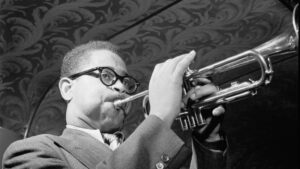
Let me take you back in time to that Easter weekend in 1987 when your dream came true and Dizzy Gillespie was on the stage at Catalina Bar and Grill. Anybody who was anyone was in the audience that night. If you could think back to who you were back in 1987 and look at where you are now, what would you have to say to the young version of yourself about everything that you’ve accomplished and everything you’ve endured and where you are today?
A lot of times people ask me if I would do it again. How would I do? What do I change? And my answer is I will never do it again, because it was very hard.
That Easter weekend was like the most exceptional and the hardest weekend of my life because I was going in it without knowing a lot. We had the best musician in the world, the most well-known. Everybody was coming to see him. We really didn’t know how to handle everything. I was trying so hard to make it and I made it. But it was very difficult.
The next day, Easter Sunday, my husband went out and he bought a whole lamb and invited everybody, all the musicians, to lunch and they had the best time of their life. That’s what happened in that Easter weekend.
I’ll tell you a little story from that time. I was seating people at the door and all kinds of people came in and I didn’t have any idea who anybody was. One guy was really pushy and I put him right in his place. Then when I went to a table, they said, “Oh, can you tell Miles to join us?” I said, “Miles?” So they said, “Miles Davis.” The one that I was pushing and I was really strong with – that was Miles Davis. I said to myself, Oh my God, what did I do because I felt very bad.
Looking back at the girl… I was not a girl, but I was much younger. I would say I grew up with this place. I turned into a very strong woman. Nothing bothers me anymore. I love all these people I work with. And if you don’t love music, don’t get in it. That’s all I can say.
Do you still love music?
I love music to the core of my heart.
To see the full interview with Catalina Popescu, please go here.
Main Photo: Catalina Popescu (Photo by Aaron Jay Young/Courtesy Catalina Jazz Club)





